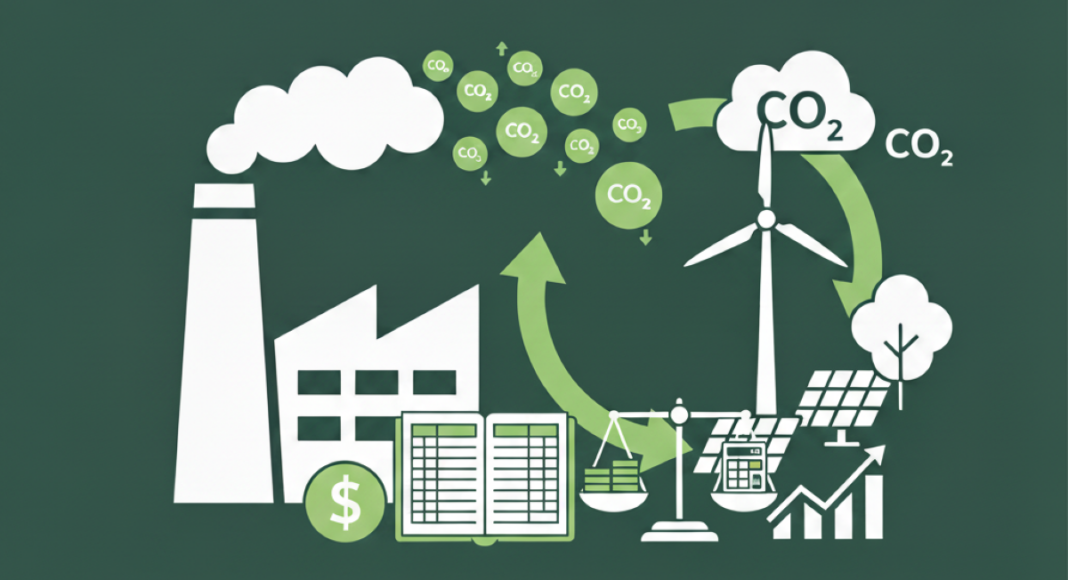Corporate decarbonization policy has stagnated under ideological divisions. Arguing that anthropogenic emissions are driven by customer preferences and that such preferences can shift with improved information, Karthik Ramanna advocates for a new approach: an economy-wide system of reliable and comparable accounts of the embedded emissions in products to allow customers (and investors) to make more-informed decisions aligned with underlying preferences. In part II of his two-part series (read part I here), Ramanna explores the principles of an accounting methodology to provide better greenhouse gas emissions data to business customers and consumers and the reasons why, based on historical precedent, such a system is readily adoptable and likely to prove effective.
In part I of this two-part series, I argued for a pro-market accounting system that would allow business customers and end consumers to track the greenhouse gas (GHG) emissions produced through the supply chain of a product. Such a system would better account for the sometimes unintuitive and unpredictable ways in which different technologies and industrial processes interact to increase or reduce emissions. It would better enable consumers and customers to make environmentally friendlier decisions, and it would avoid the broader backlash against top-down regulations that have mired decarbonization efforts. To begin part II, I discuss the key features of this accounting metric for supply-chain GHG emissions.
Key features of the metric
GAAP or Generally Accepted Accounting Principles, produced in the United States and internationally under public authority, is broadly considered the gold standard for reliably measuring and comparing corporate financial performance. We need such equivalent accounting principles for GHG emissions.
At the core of GAAP are some basic accountability concepts, such as avoiding double counting the same transaction and not concealing any relevant costs. An associated central feature of GAAP is what’s known as the entity concept: the idea that an entity is responsible for all actions under its control and only those actions. This concept ensures, for instance, that transactions between related parties cannot be used to obfuscate an entity’s true performance and, conversely, that the entity cannot claim credit for the performance of arm’s-length counterparties.
Even as these concepts are uncontroversial in financial accounting, they are today absent from widely used disclosure principles for corporate carbon performance. The most commonly used of these disclosure principles are those prepared by the Greenhouse Gas Protocol (GHGP), although principles are also prepared by a host of other organizations including the International Organization for Standardization (ISO) and various regional and sectoral associations.
For instance, under current GHGP disclosure practices, firms can report industry-average emissions performance as their own, obviating any incentive for accuracy and auditability. This would be equivalent to the U.S. Securities and Exchange Commission (SEC) authorizing accounting standards that allow companies to coopt industry-average profit margins as their own.
The GHGP also prescribes (under its “Scope 3” approach) multiple counting of the same emissions across entities. When pressed, its advocates have noted that this sort of overstatement is a “feature not a bug,” as it raises the social salience of climate change and the drive to reduce emissions. Of course, this is absurd: such multiple counting violates the centuries-old entity concept that evolved to keep corporate reporting honest, undermines public trust in emissions reporting as a whole, and renders the GHGP unusable as a performance metric to inform and incentivize markets to advance decarbonization innovations.
What’s important to note about the GHGP and most of the various other disclosure principles for corporate climate reporting currently available is that they do not really constitute accounting standards. Accounting, as a body of practice and knowledge, has certain core properties, like fungibility, comparability, consistency, and verifiability. The disclosure principles of the GHGP, for instance, do not result in corporate performance reports that are fungible or even comparable. And they cannot be verified to the general standard expected of financial accounts, which is called “reasonable assurance” in corporate governance lingo. So, a void exists into which we must rapidly supply a GAAP-like emissions accounting system.
Some four years ago now, together with Bob Kaplan, I started to develop the principles for a rigorous accounting system for GHG emissions and removals. (An example of removals could be long-term virgin forestation to sequester carbon dioxide.) Under the system, GHG emissions would be recorded as E- (or environmental) liabilities, just as the credible removals of atmospheric GHGs would be recorded as E-assets. An entity or product’s claim to net zero would be established when, on its relevant E-ledger, its E-liabilities were equaled by its E-assets, as calculated under the rigorous principles and verified by an external auditor.
At an intuitive level the system works like the value-add approach. In essence, companies must account for their direct emissions on their E-ledgers, and, when they purchase inputs from suppliers, for the emissions embedded in those inputs. When they sell outputs to their customers, the embedded emissions of those outputs, as calculated under allocation principles, would be transferred to those customers’ E-ledgers.
The E-ledger approach accounts for GHG emissions from global commercial activity at the level of individual products and in a manner that is specific to those products (and hence accurate). As companies have to transfer embedded emissions in outputs to their customers when they make a sale, the E-ledger system incentivizes them to innovate to lower their incurred emissions to stay competitive.
There are other advantages to this approach, including its fungibility and avoidance of double counting. By making the system ledger-based, the approach also accounts for emissions and removals on a capitalized basis, meaning, for instance, emissions incurred over multiple periods (such as emissions from capital equipment like a hydropower dam) are accounted for across those periods rather than all at once. But perhaps the approach’s most useful feature is that it is already familiar to the millions of accountants and finance personnel in companies and markets (who have been educated in related financial-accounting concepts), so it is relatively low-cost to deploy. Moreover, the approach is auditable to the same high-standard as financial accounts and uses similar principles and governance institutions.
In joint work with Marc Roston, Kaplan and I have further noted that legitimate removals (E-assets) must be expected to last for at least as long as GHG emissions linger in the atmosphere, estimated currently at between 300 and 1,000 years for carbon dioxide. Very few removals currently trading in the market for carbon offsets actually meet this condition. Most such removals are short-duration, tree-planting offsets that are expected to last under 50 years. Without the duration requirement in the definition of E-assets, using removals to net out E-liabilities, toward claims of net zero, would be akin to making a small handful of monthly payments on one’s 30-year home mortgage and claiming that the mortgage is now paid off.
As a practical matter, these rigorous definitions of E-liabilities and E-assets mean that almost no product or entity today is actually net zero. Take tire-making, for example. Tires are essential to most modern transportation, which in turn is an essential element of almost all supply chains for all products and services. Tire-making requires inputs like carbon black, steel cord, and synthetic rubber, together with processes like curing, none of which can exist at scale, today or into the foreseeable future, without fossil fuels. And for the fossil-fuel emissions to be truly offset by removals of atmospheric GHGs, those removals must be real and near-permanent. Today removal activities of this sort are few and far between. Direct air capture (DAC) of carbon dioxide with subterranean mineralization of the captured carbon is an example of a true E-asset to offset fossil-fuel emissions, but current global annual DAC capacity is less than 0.1 million tons, compared to over 35 billion tons of annual carbon dioxide emissions from fossil fuels.
My objective in highlighting this accounting reality is to emphasize how serious the innovation task ahead really is. Happily, in the four years since Kaplan and I introduced the E-ledger approach, several companies in industries such as cement, steel, energy, automotives, and tires have begun piloting the process. As such, there is no limitation to the sectors or products to which the E-ledgers approach can apply. The system enables all products at all stages of the supply chain to have verifiable emissions labels—from iron ore to Uber rides, from McKinsey consulting to knee-replacement surgeries. As long as customers are willing to pay more for substitutable products with fewer embedded emissions, the financial benefits to adopting the approach can outweigh its costs. Of course, it is difficult to predict beforehand which products will generate sufficient price differentiation based on emissions savings and which will not. But the universality of the system is its strength, allowing markets to make those choices dynamically and across sectors, as technologies and product alternatives evolve. Moreover, by commoditizing GHG emissions, the approach effectively de-commoditizes all other commodities—from bags of cement to barrels of oil to gigabytes of cloud storage. This reorients markets to rewarding the reduction of GHG emissions without governmental inference.
Seeking precedents and win-wins to put the metric in place
Thus far, I have introduced two simple propositions: that anthropogenic GHG emissions can be addressed through bottom-up, customer-led, market-driven innovation; and that this requires a GAAP-like emissions-accounting metric to coordinate market action. How can we get from these propositions to making real and rapid progress on decarbonization?
GAAP was not always as well-established as it is today. In the roaring 1920s, there were few controls over how companies decided when assets or revenue could be recognized and when liabilities had to be recorded. As a result, corporate financial accounts were unreliable and incomparable by today’s standards. The situation enabled widespread manipulation of stock prices and eventually the Great Crash of 1929. It was only thereafter that Congress created the SEC, which went about first assembling GAAP as we now know it.
What’s remarkable is that in a reasonably short period of about five years from 1935 to 1940, leaders in business and public service organized the systemwide measures for corporate financial performance. Now is the time to recreate that moment with emissions accounts. Just as GAAP has enhanced the economic efficiency of market allocations across the planet (think of all the trillions in value created since we eliminated the wholesale accounting misrepresentation of the 1920s), so too could robust GHG accounting improve the emissions efficiency of markets.
Given the skepticism around climate change amongst powerful political constituencies around the world, one might ask whether this sort of universal emissions accounting system is feasible. My response, drawing from over a decade of research on building unlikely coalitions, is to note that change often requires starting with addressing those parts of the problem that don’t require powerful players to make major sacrifices. In that vein, the most immediate win-win opportunity to make progress on atmospheric decarbonization lies in leveraging the already existing variance in emissions efficiency across products, companies, and countries.
For instance, economic nationalism is on the rise across the world, and especially in developed countries where middle-income people feel their own wages and standards of living have been eroded through decades of globalization. In the U.S. and Europe, governments across the political spectrum are considering some sort of tariff structure in part to promote decarbonization, but mainly to protect and boost their domestic manufacturing sectors that have traditionally provided a comfortable living to those segments of the population that are not college educated.
Rather than reject these forces as insular, we can embrace their momentum to also make progress on emissions reduction. Manufacturing in the developed world tends to produce, on average, lower emissions than that in the Global South, largely due to differences in used energy sources. So, a (sensibly ramped-up) tariff on goods imports into the U.S. and Europe can, in fact, become a win-win.
Critically though, such a tariff should be emissions-driven rather than blanket discriminatory. That is, rather than tax all imports simply based on their point of origin, assess imports based on the excess of their specific embedded emissions over equivalent domestic products. This performance-driven approach (i) incentivizes offshore manufacturers to improve their products’ emissions efficiency, and (ii) prevents domestic manufacturers from getting lazy, as they too have to continually improve emissions efficiency to keep their tariff-based advantage.
Such performance-based tariffs do, of course, require an underlying emissions accounting system to run on: one cannot levy a tariff on an import without having an assessment basis. With that political impetus, we can establish the necessary product-level emissions accounting system, as a public good under public authority, just like GAAP.
This emissions accounting system, perhaps jointly introduced by the U.S. and the EU through a purpose-built international organization such as an Emissions Accounting Board, need apply only to imported products, imposing no additional requirements on domestic companies (which have proven to be unpopular in many jurisdictions).
The system, as it applies to imported products, would also not necessitate any entity-level public disclosures akin to corporate financial reporting of balance sheets and income statements. In this vein, it is worth distinguishing between accounting rules and rules requiring public reporting of accounts. For instance, GAAP refers to the accounting rules under which financial reports are prepared, but not to the rules that require the public disclosure of those reports (which are separately promulgated by the SEC for listed companies). Similarly, what I argue for here are rules for product-level accounts; not rules for the public reporting of those accounts, at the product- or entity-level. Indeed, those accounts are likely to contain commercial secrets, and companies are likely to be reluctant to report them publicly. All that a company really needs to report under the proposal above, and only to its customers and relevant customs authorities, are the product-level emissions accounts for the products sold to those customers by means of importation.
An emissions-based tariffs of international trade may seem not transformational enough in scale to make a dent in the GHG problem. Even if true, my contention is that such a step kickstarts the otherwise beached process of decarbonization. When in place, an emissions accounting system will invariably find additional applications in the sort of voluntary markets for decarbonization described in part I, even expanding the scale of those markets. For example, while GAAP in the U.S. is statutorily only required of listed companies, many private companies use GAAP as a matter of convenience and a signal of quality to secure more-favorable terms for private borrowing and trade credit.
Once GAAP-like emissions accounting is introduced as a general worldwide requirement for foreign trade (which even bilateral adoption by the U.S. and European Union would effectively do), companies subject to that requirement could not easily shift emissions to other entities, as those entities would then have to account for the emissions themselves. Indeed, if the U.S. and EU introduced such an accounting system, the only recourse for companies seeking to avoid accurate reporting of emissions on their products would be to opportunistically transfer emissions to third-parties outside the regulatory purview of the system, and that itself would raise flags and could be policed through border carbon adjustments that penalizes imports from third-parties that do not participate in the accounting system. For instance, the EU has considered a levy on select imported products without proper and verified carbon accounts that uses values from the highest percentiles of the emissions distribution of those product categories. That would certainly create a turbo incentive for exporters to get their emissions accounting right and, more importantly, to lower their emissions.
Implementation complexities and other limitations of the approach
Here is a good place to clarify that my proposal to address anthropogenic GHG emissions works at speed and scale only when we have sound product-level emissions accounting rules that are robustly enforced via international auditing and commercial courts. Put differently, there is an ecosphere of market-governance institutions that makes GAAP accounts trustworthy and decision-useful, which we will need to replicate in this context. For example, just as the Public Company Accounting Oversight Board helps maintain the integrity of major companies’ financial accounts through worldwide inspections of their auditors, we would need a similar capability in the emissions-based tariff system for product-level accounts to be trusted by customers and customs authorities.
We cannot also assume that countries outside the U.S. and EU will accept emissions-based tariffs lying down. For instance, China, which could at first be most hit by such tariffs, may retaliate by banning exports of certain critical minerals, prompting further macroeconomic effects. So, the costs of such tariffs are not negligible, but given their dynamic, performance-based nature, the long-run costs are likely considerably lower than those of static, location-based tariffs already proposed by the U.S.
An additional concern with emissions-based tariffs by Western countries is that they will disproportionately hurt the Global South. A border carbon system may punish the poorest countries, many of which have to bear the brunt of climate change that is due largely to the industrialization of the richer countries. This situation certainly merits a response: moral adjustments must be built in to protect the most vulnerable. But solutions to poverty do not need to forestall practicable progress on decarbonization. With appropriate development finance to the poorest, we can harness the value of a tariff that incentivizes decarbonization globally.
Moreover, many countries that will be affected by a Western carbon tariff are not necessarily poor. In fact, the economic nationalism in the U.S. and EU that has created the political space for such tariffs would not have arisen had other “developing” countries not become so successful by onshoring previously Western industries.[1] [KR2]
More generally, this “tariffs are anti-Global South” criticism assumes a somewhat static capacity of firms in emerging markets to decarbonize. A worldwide emissions accounting system, as it is iteratively deployed, will likely shift consumer behavior and public opinion (as we saw in the case of nutrition labelling), encouraging still more companies to innovate to compete on low emissions. Pilot studies on implementing product-level emissions accounts with firms operating in low-income countries, including even in Afghanistan, in fact suggest that the firms are amply capable of innovating their processes to comply with higher emissions thresholds.
Connecting the metric to existing corporate climate disclosure efforts
Not all the information relevant to emissions-based decision-making in markets will be communicated via the E-ledger system described above. Just as a company complements its GAAP financial accounts with voluntary disclosures about its (prospective) performance—such as disclosures on future opportunities aimed at investors, disclosures about product-quality features aimed at customers, etc.—we can expect companies to complement their E-ledger-based product-level accounts with additional disclosures. This will be especially the case for companies that are consumer facing that want their customers to understand, beyond the benefits of buying a product that is low emissions to produce, how the product’s features can help the customer save emissions or costs over its use.
For instance, a company selling low-emissions (but high-cost) tires may want to communicate that such tires can actually last longer and generate lower emissions in use due to their lower rolling friction, saving the customer money and lowering the customer’s own emissions footprint. This sort of prospective emissions information cannot be communicated through an accounting system (which is, by definition, focused on verifiably delivered performance), since it is inherently speculative, being based partly on the customer’s own behavior. Here, promotional disclosure by companies can fill the information void, but such information is more marketing than accounting.
Much of the current corporate climate reporting efforts are in fact of this disclosure ilk. Such disclosure does play an important additive role in markets, but experience from corporate financial reporting suggests that forward-looking disclosure without a bedrock of verifiable accounting information upon which to “true up” prospective performance claims can be a recipe for puffery and even fraud. Indeed, there are widespread concerns about the reliability of current corporate climate disclosures, which are not surprising as disclosure is inherently unverifiable to the standards of assurance used in accounting. Properly assured accounts that complement disclosures make those disclosures more reliable. So, the urgent task remains to build a robust product-level emissions accounting system.
Indeed, a number of climate-reporting regulatory initiatives have sputtered and even failed because they have been based on the disclosure-only approach. Consider, for instance, the SEC’s ill-fated attempt from 2021 to 2024 to introduce the GHGP’s “Scope 3”-based climate disclosure requirements. The unverifiable basis of Scope 3 is antithetical to the SEC’s own rigorous, market-enabling approach to corporate performance measurement. Not surprisingly then, the effort collapsed under an avalanche of bipartisan criticism. A similar fate likely awaits California’s Senate Bill 219, which requires Scope 3 disclosures beginning in 2027 for certain large companies doing business in the state.
Likewise, in the EU, a plethora of disclosure-only climate regulation was created in recent years, including the compliance-heavy Corporate Sustainability Reporting Directive (CSRD) in 2023 and Corporate Sustainability Due Diligence Directive (CSDDD) in 2024. But by 2025, both of these regulations were subject to a “stop-the-clock” directive by an overwhelming vote of the European Parliament: 531 to 69. While all these reversals might well be cause for alarm, the situation does suggest an opportunity for a pro-market emissions-accounting approach to driving decarbonization.
The good news is that there are several initiatives already emerging, such as the automotive industry’s Catena-X data ecosystem, the chemical industry’s Together for Sustainability guidelines, the EU’s Digital Product Passport initiative, and the World Business Council for Sustainable Development’s Partnership for Carbon Transparency (PACT) methodology, that can provide tailwinds to the policy momentum needed. These variously provide sectoral infrastructure for initializing emissions data transfer through supply chains that is needed for long-run robust E-ledger accounting.
Conclusion
My core premises in this two-part article are that anthropogenic GHG emissions are primarily due to customer preferences and that such preferences can shift with improved information. These pro-market premises are, admittedly, not uncontroversial in the climate community. But, I argue, our market system is already adapting to the new realities of high GHG levels in the atmosphere, as we have seen from some of the examples discussed here and in part I. The trouble really is that some features of the system—most notably, the absence of a coordinating universal performance metric—mean that it is not responding as efficiently and quickly as it could. So, rather than throw the baby out with the bathwater and constrain economic activity from the top-down to save the planet (which is in itself a highly unrealistic policy position), we need to give the system a data-driven boost. We did something similar in the 1930s, when we first introduced GAAP financial accounting to channel capitalism’s energy to deliver real financial returns in the context of (emerging) highly diversified stockholdings. Now, we need an equivalent robust system of emissions accounting. With that, we will have primed our best-known force for decentralized problem-solving to address what is perhaps our greatest collective challenge as a species to date.
Author Disclosure: Karthik Ramanna is Professor of Business and Public Policy at the University of Oxford’s Blavatnik School of Government. He is also co-founder and Principal Investigator of the non-profit E-ledgers Institute and co-chair of the independent Expert Panel on Carbon Accounting hosted by the International Chamber of Commerce and the Carbon Measures Association. The views expressed here are the author’s alone and may not necessarily reflect the views of the institutions with which he is affiliated.
Articles represent the opinions of their writers, not necessarily those of the University of Chicago, the Booth School of Business, or its faculty.
Subscribe here for ProMarket’s weekly newsletter, Special Interest, to stay up to date on ProMarket’s coverage of the political economy and other content from the Stigler Center.







